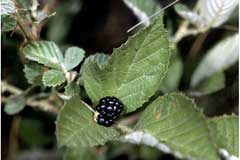Difference between revisions of "Rubus cuneifolius"
(→Ecology) |
|||
| Line 32: | Line 32: | ||
==Ecology== | ==Ecology== | ||
===Habitat=== <!--Natural communities, human disturbed habitats, topography, hydrology, soils, light, fire regime requirements for removal of competition, etc.--> | ===Habitat=== <!--Natural communities, human disturbed habitats, topography, hydrology, soils, light, fire regime requirements for removal of competition, etc.--> | ||
| − | ''R. cuneifolius'' commonly inhabits woodlands, forests, and disturbed areas.<ref name="Weakley 2015"/> | + | ''R. cuneifolius'' commonly inhabits woodlands, forests, and disturbed areas.<ref name="Weakley 2015"/> This includes early successional areas.<ref name="Chappelka 2002">Chappelka A. H. (2002). Reproductive development of blackberry (''Rubus cuneifolius''), as influenced by ozone. New Phytologist 155-249-255.</ref> |
===Phenology===<!--Timing off flowering, fruiting, seed dispersal, and environmental triggers. Cite PanFlora website if appropriate: http://www.gilnelson.com/PanFlora/ --> | ===Phenology===<!--Timing off flowering, fruiting, seed dispersal, and environmental triggers. Cite PanFlora website if appropriate: http://www.gilnelson.com/PanFlora/ --> | ||
Revision as of 14:40, 8 December 2017
| Rubus cuneifolius | |
|---|---|

| |
| Photo by Robert H. Mohlenbrock hosted at USDA NRCS Plants Database. | |
| Scientific classification | |
| Kingdom: | Plantae |
| Division: | Magnoliophyta - Flowering plants |
| Class: | Magnoliopsida - Dicots |
| Order: | Rosales |
| Family: | Rosaceae - Rose family |
| Genus: | Rubus - blackberry |
| Species: | R. cuneifolius |
| Binomial name | |
| Rubus cuneifolius Pursh | |

| |
| Natural range of Rubus cuneifolius from USDA NRCS Plants Database. | |
Common Name(s): sand blackberry[1][2], sand bramble, wedge sand blackberry[2]
Contents
Taxonomic Notes
Varieties: R. cuneifolius var. angustior; R. cuneifolius var. subellipticus; R. cuneifolius var. spiniceps[2]
Synonym(s): R. chapmannii; R. dixiensis
Description
Rubus cuneifolius is a dioecious perennial subshrub.[2]
Distribution
R. cuneifolius is found primarily on the coastal plains from Connecticut and New York south to Florida, Alabama, Mississippi and Louisiana.[1][2]
Ecology
Habitat
R. cuneifolius commonly inhabits woodlands, forests, and disturbed areas.[1] This includes early successional areas.[3]
Phenology
Flowering occurs between March and June, peaking in April.[1][4]
Use by animals
Berries produced by R. cuneifolius are highly palatable by browsing animals, composing 10-25% of the diet for many species of terrestrial birds, large mammals and small mammals. It is also an occasional source of cover for small mammals and terrestrial birds.[2]
Conservation and Management
Cultivation and restoration
Photo Gallery
References and notes
- ↑ 1.0 1.1 1.2 1.3 Weakley A. S.(2015). Flora of the Southern and Mid-Atlantic States. Chapel Hill, NC: University of North Carolina Herbarium.
- ↑ 2.0 2.1 2.2 2.3 2.4 2.5 USDA, NRCS. (2016). The PLANTS Database (http://plants.usda.gov, 30 November 2017). National Plant Data Team, Greensboro, NC 27401-4901 USA.
- ↑ Chappelka A. H. (2002). Reproductive development of blackberry (Rubus cuneifolius), as influenced by ozone. New Phytologist 155-249-255.
- ↑ Nelson G. (6 December 2017) PanFlora. Retrieved from gilnelson.com/PanFlora/